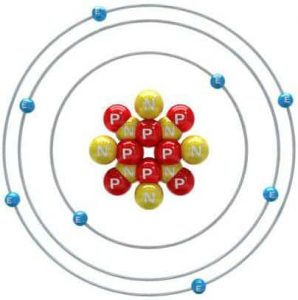OXIDATIVE STRESS AND AGEING
Oxidative Stress has recently been stressed as one of the important causes of ageing, hence the importance of Antioxidants for health.
In order to understand Oxidative Stress we must start at the molecular level. All matter in the universe is made of atoms. An atom composed of a core with protons (red) and neutrons (yellow), and a bunch of electrons (blue) that revolve around the core as shown in the figure 7.1.
When two or more atoms are linked together, they become what we know as molecules. The human body is made up of substances like proteins, fats and DNA, which are basically just large molecules with dozens, hundreds or thousands of atoms joined together.
Humans and other organisms maintain their structure and function by chemical reactions. All the chemical reactions needed to sustain life are collectively known as metabolism. In these chemical reactions, bigger molecules are broken down into smaller molecules, and smaller molecules are organized into bigger molecules.
In order for a molecule to be stable, it must contain the right amount of electrons. If the molecule loses an electron it can turn into a free radical. Free radicals are unstable, electrically charged molecules in the cells that can react with other molecules (like DNA) and damage them. They can even form chain reactions, where the molecules they damage also turn into free radicals.
Oxidative stress is essentially an imbalance between the production of free radicals and the ability of the body to counteract or detoxify their harmful effects through neutralization by antioxidants.

The figure depicts an atom, showing various elements like neutrons (yellow), protons (red) and electrons (blue).
Prolonged oxidative stress leads to increased risk of negative health outcomes, such as cardiovascular disease and certain types of cancer. It is also thought to contribute to the ageing process.
Several stress factors and lifestyle habits are known to promote excessive free radical formation and oxidative stress. Some of them are as follows:
- Air pollution.
- Cigarette smoke.
- Alcohol intake
- Toxins
- Uncontrolled diabetes
- Consuming large amounts of polyunsaturated fatty acids
- Radiation exposure
- Infections by bacteria, fungi or viruses which means large number of diseases
- Too little oxygen in the body or low oxygen atmosphere
- Intense and prolonged exercises
- Antioxidant deficiency in the body
Location
Indian Association of Age Management
c/o Naraina Medical Centre
NH-1, Community Centre, C-Block
Naraina Vihar, New Delhi 110028